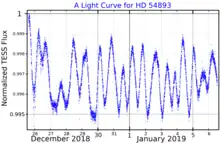 | |
| Observation data Epoch J2000.0 Equinox J2000.0 (ICRS) | |
|---|---|
| Constellation | Puppis |
| Right ascension | 07h 08m 51.06814s[1] |
| Declination | −39° 39′ 20.3590″[1] |
| Apparent magnitude (V) | 4.83[2] |
| Characteristics | |
| Spectral type | B2IV-V[3] |
| U−B color index | −0.69[2] |
| B−V color index | −0.18[2] |
| Variable type | suspected β Cep[4] |
| Astrometry | |
| Radial velocity (Rv) | +19.50[5] km/s |
| Proper motion (μ) | RA: −10.577[1] mas/yr Dec.: +7.785[1] mas/yr |
| Parallax (π) | 3.7743 ± 0.0894 mas[1] |
| Distance | 860 ± 20 ly (265 ± 6 pc) |
| Absolute magnitude (MV) | −2.05[6] |
| Details | |
| Mass | 6.3[1] M☉ |
| Radius | 7.0[1] R☉ |
| Luminosity | 2,389[1] L☉ |
| Surface gravity (log g) | 3.56[1] cgs |
| Temperature | 15,974[1] K |
| Metallicity [Fe/H] | +0.20[1] dex |
| Rotational velocity (v sin i) | 42.8[7] km/s |
| Age | 21.6[8] Myr |
| Other designations | |
| Database references | |
| SIMBAD | data |

HD 54893, often called A Puppis is a suspected variable star in the constellation Puppis. Its apparent magnitude is 4.83 and is approximately 860 light years away based on parallax.
With a mass over six times that of the Sun, HD 54893 is a hot luminous star with an effective temperature of about 16,000 K and a bolometric luminosity of 2,400 L☉. The spectral class of B2IV/V suggest it is on the border between the main sequence and the subgiant branch. Evolutionary models show it is towards the end of the main sequence at an age of about 22 million years.
In a 1971 paper, HD 54893 is mentioned as being a confirmed β Cephei variable, but with no explanation of when it was discovered.[11] A 1971 thesis dedicated to β Cephei variables only mentions HD 54893 as a non-variable early B star.[12] In a 1977 search for β Cephei stars, it is listed as possibly being variable.[13] It is catalogued as a suspected variable star, but not confirmed.[4]
References
- 1 2 3 4 5 6 7 8 9 10 11 Vallenari, A.; et al. (Gaia collaboration) (2023). "Gaia Data Release 3. Summary of the content and survey properties". Astronomy and Astrophysics. 674: A1. arXiv:2208.00211. Bibcode:2023A&A...674A...1G. doi:10.1051/0004-6361/202243940. S2CID 244398875. Gaia DR3 record for this source at VizieR.
- 1 2 3 Ducati, J. R. (2002). "VizieR Online Data Catalog: Catalogue of Stellar Photometry in Johnson's 11-color system". CDS/ADC Collection of Electronic Catalogues. 2237. Bibcode:2002yCat.2237....0D.
- ↑ Hiltner, W. A.; Garrison, R. F.; Schild, R. E. (July 1969). "MK Spectral Types for Bright Southern OB Stars". The Astrophysical Journal. 157: 313. Bibcode:1969ApJ...157..313H. doi:10.1086/150069. eISSN 1538-4357. ISSN 0004-637X.
- 1 2 Samus, N. N.; Durlevich, O. V.; et al. (2009). "VizieR Online Data Catalog: General Catalogue of Variable Stars (Samus+ 2007-2013)". VizieR On-line Data Catalog: B/GCVS. Originally Published in: 2009yCat....102025S. 1. Bibcode:2009yCat....102025S.
- ↑ Wilson, R. E. (1953). "General Catalogue of Stellar Radial Velocities". Carnegie Institute Washington D.C. Publication. Carnegie Institution for Science. Bibcode:1953GCRV..C......0W. LCCN 54001336.
- ↑ Anderson, E.; Francis, Ch. (2012). "XHIP: An extended hipparcos compilation". Astronomy Letters. 38 (5): 331. arXiv:1108.4971. Bibcode:2012AstL...38..331A. doi:10.1134/S1063773712050015. S2CID 119257644. Vizier catalog entry
- ↑ Glebocki, R.; Gnacinski, P. (2005). "VizieR Online Data Catalog: Catalog of Stellar Rotational Velocities (Glebocki+ 2005)". VizieR On-line Data Catalog: III/244. Originally Published in: 2005csss...13..571G; 2005yCat.3244....0G. 3244. Bibcode:2005yCat.3244....0G.
- ↑ Tetzlaff, N.; Neuhäuser, R.; Hohle, M. M. (2011). "A catalogue of young runaway Hipparcos stars within 3 kpc from the Sun". Monthly Notices of the Royal Astronomical Society. 410 (1): 190–200. arXiv:1007.4883. Bibcode:2011MNRAS.410..190T. doi:10.1111/j.1365-2966.2010.17434.x. S2CID 118629873. Vizier catalog entry
- ↑ Gould, Benjamin Apthorp (1878). "Uranometria Argentina : brillantez y posicion de las estrellas fijas, hasta la septima magnitud, comprendidas dentro de cien grados del polo austral : con atlas". Resultados del Observatorio Nacional Argentino. 1. Bibcode:1879RNAO....1.....G.
- ↑ "MAST: Barbara A. Mikulski Archive for Space Telescopes". Space Telescope Science Institute. Retrieved 8 December 2021.
- ↑ Percy, John R.; Madore, Katherine (1971). "On Stothers' and Simon's Binary-Star Hypothesis for Beta Canis Majoris Star Pulsation". International Astronomical Union Colloquium. 15: 197–203. doi:10.1017/S0252921100032954. S2CID 124791098.
- ↑ Watson, Robert Dudley (1971). A study of the beta Cephei stars (Thesis).
- ↑ Jerzykiewicz, M.; Sterken, C. (1977). "Search for beta Cephei stars south of declination -20 . I. Incidence of light variability among early B giants and subgiants - summer objects". Acta Astronomica. 27: 365. Bibcode:1977AcA....27..365J.